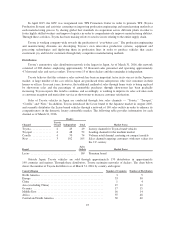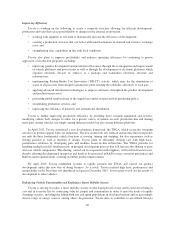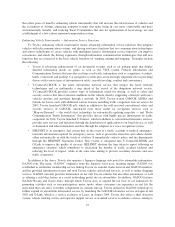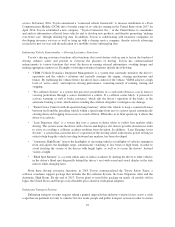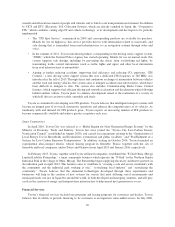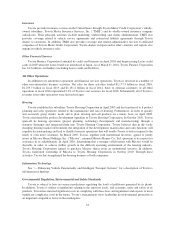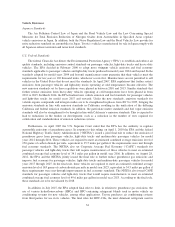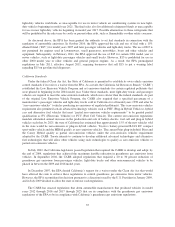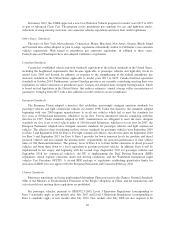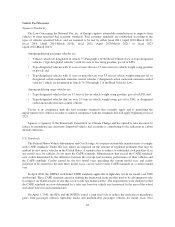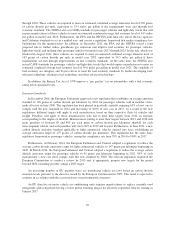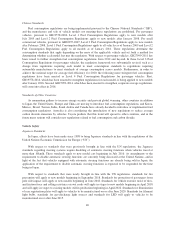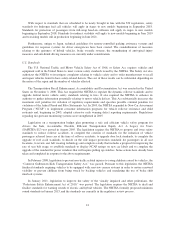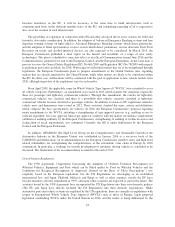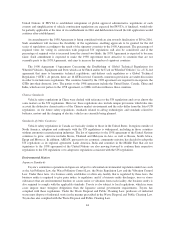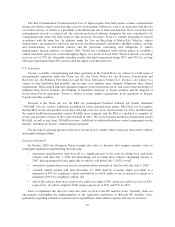Toyota 2015 Annual Report Download - page 40
Download and view the complete annual report
Please find page 40 of the 2015 Toyota annual report below. You can navigate through the pages in the report by either clicking on the pages listed below, or by using the keyword search tool below to find specific information within the annual report.light-duty vehicles worldwide, as unacceptable for use in motor vehicle air conditioning systems in new light-
duty vehicles beginning in model year 2021. The final rules also list additional refrigerant blends as unacceptable
for use in new light-duty vehicles beginning in model year 2017. Feasible alternatives to these refrigerants that
will be prohibited by the rules may be costly or present other risks, such as flammability or other safety concerns.
As discussed above, the EPA has been granted the authority to set fuel standards in connection with the
regulation of automobile emissions. In October 2010, the EPA approved the sale and use of fuel with a 15%
ethanol blend (“E15”) for model years 2007 and later passenger vehicles and light-duty trucks. The use of E15 is
not permitted for engines used in lawnmowers, small generators, motorbikes, boats and other vehicles and
equipment. Subsequently, in February 2011, the EPA approved the use of E15 for certain 2001 model year or
newer vehicles, such as light-duty passenger vehicles and small trucks. However, E15 is prohibited for use in
other 2000 model year or older vehicles and general purpose engines. As a result, the EPA promulgated
regulations in July 2011, effective August 2011, requiring businesses that sell E15 to put a warning label
regarding E15 on gasoline fuel dispensers.
California Standards
Under the federal Clean Air Act, the State of California is permitted to establish its own vehicle emission
control standards if it receives a waiver from the EPA. As a result, the California Air Resources Board (“CARB”)
established the Low Emission Vehicle Program and set emission standards for certain regulated pollutants that
were phased in beginning in the 2004 model year. Under these standards, most light-duty trucks and passenger
vehicles are required to meet the same emission standards, which were stricter than the federal standards. As part
of the original Low Emission Vehicle Program, the CARB also required that a specified percentage of a
manufacturer’s passenger vehicles and light-duty trucks sold in California for all model years 1998 and after be
“zero-emission vehicles” (vehicles producing no emissions of regulated pollutants). This zero-emission vehicles
requirement also permitted certain advanced technology vehicles such as PHV (Plug-in Hybrid Vehicles), hybrid
cars and alternative fuel vehicles that meet “partial zero-emission vehicles requirements” to be granted partial
qualification as EV (Electronic Vehicles) or FCV (Fuel Cell Vehicle). The current zero-emission regulations
mandate substantial annual increases in the production and sale of battery-electric, fuel cell and plug-in hybrid
vehicles such that, by 2025, the state of California has estimated that approximately 15% of the new vehicles sold
in the state would be zero-emission or plug-in hybrid vehicles. Toyota’s battery-powered RAV4 EV compact
sport-utility vehicle and the MIRAI qualify as zero-emission vehicles. The current Prius plug-in hybrid, Prius and
the Camry Hybrid qualify as partial zero-emission vehicles under the zero-emission vehicles requirement
adopted by the CARB. Toyota intends to continue to develop additional advanced technologies and alternative
fuel technologies that will allow other vehicles using such technologies to qualify as zero-emission vehicles or
partial-zero-emission vehicles.
In July 2002, the California legislature passed legislation that required the CARB to develop and adopt, by
the end of 2004, regulations that achieved the maximum feasible reduction in greenhouse gas emissions from
vehicles. In September 2004, the CARB adopted regulations that required a 20 to 30 percent reduction of
greenhouse gas emissions from passenger vehicles, light-duty trucks and other noncommercial vehicles to be
phased in between the 2009 and 2016 model years.
In December 2007, the EPA denied California’s request for a waiver under the Clean Air Act that would
have allowed the state to enforce these regulations to control greenhouse gas emissions from motor vehicles.
However, the EPA reconsidered its decision pursuant to a direction issued by the U.S. President in January 2009,
and in July 2009 decided to allow the state to enforce such regulations.
The CARB has enacted regulations that deem automobile manufacturers that produced vehicles in model
years 2012 through 2016 and 2017 through 2025 that are in compliance with the greenhouse gas emissions
regulations of the EPA to be in compliance with California’s greenhouse gas emissions regulations.
35


